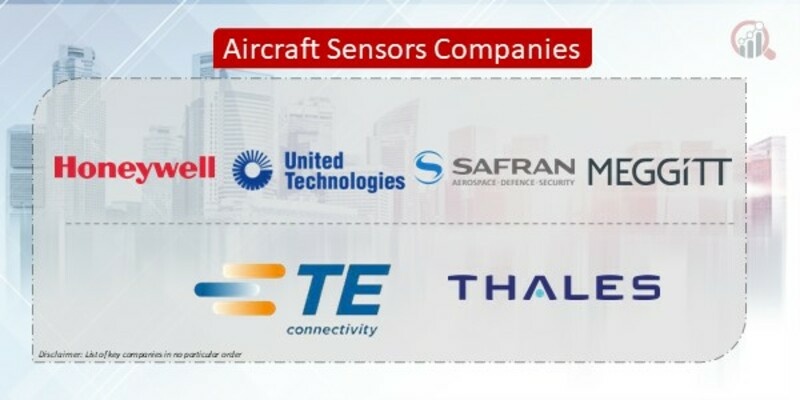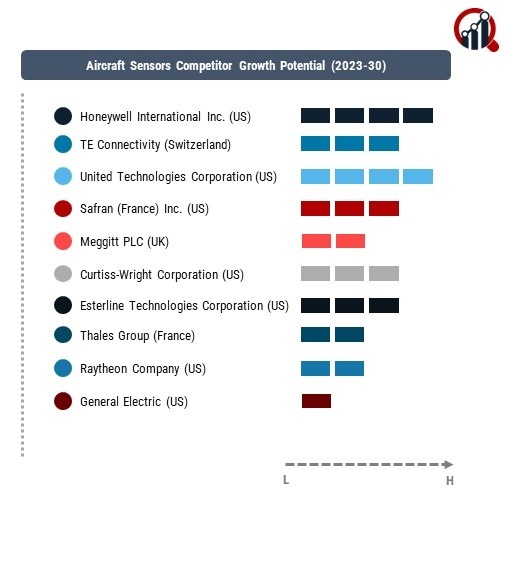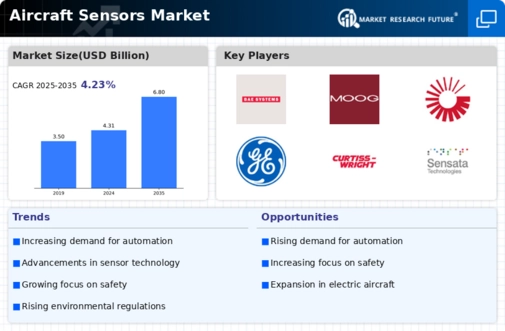Top Industry Leaders in the Aircraft Sensors Market

Global Aircraft Sensors Market Outlook
The competitive landscape of the Aircraft Sensors Market is characterized by a dynamic and evolving ecosystem, driven by advancements in aviation technology and the growing demand for enhanced safety, efficiency, and performance in the aerospace industry. Key players in this market are continually investing in research and development to introduce innovative sensor solutions that cater to the evolving needs of aircraft manufacturers and operators.
Key Companies in the aircraft sensors market include
- Honeywell International Inc. (US)
- TE Connectivity (Switzerland)
- United Technologies Corporation (US)
- Safran (France) Inc. (US)
- Meggitt PLC (UK)
- Curtiss-Wright Corporation (US)
- Esterline Technologies Corporation (US)
- Thales Group (France)
- Raytheon Company (US) General Electric (US)
- Eaton Corporation (Ireland)
- Crane Aerospace & Electronics (US)
- Stellar Technology (US)
- Custom Control Sensors LLC (US)
- Brunswick Corporation
To maintain their competitive edge, key players are adopting strategies such as mergers and acquisitions, partnerships, and collaborations. This approach allows companies to expand their product portfolios, leverage complementary technologies, and enhance their market presence. For instance, recent partnerships between sensor manufacturers and aircraft OEMs have enabled the integration of sensors directly into aircraft systems, offering seamless solutions to end-users.
Market share analysis in the aircraft sensors sector is influenced by several factors, including technological advancements, regulatory frameworks, and strategic alliances. The increasing emphasis on fuel efficiency and environmental sustainability has driven the adoption of advanced sensors that contribute to the optimization of aircraft performance. Players gaining a competitive advantage often leverage their technological expertise to develop sensors that are not only reliable but also energy-efficient, aligning with the industry's focus on sustainability.
The entry of new and emerging companies further intensifies competition in the aircraft sensors market. These companies often bring fresh perspectives and innovative solutions, challenging established players. Start-ups focusing on niche sensor technologies, such as remote sensing and smart sensors, are gaining traction. The competitive landscape is evolving with the influx of agile and innovative players, adding diversity to the market.
Industry news reflects the continuous evolution of the competitive scenario in the aircraft sensors market. Notable developments include breakthroughs in sensor miniaturization, the integration of artificial intelligence for real-time data analysis, and the deployment of sensors for predictive maintenance. These advancements not only enhance the capabilities of aircraft but also drive the demand for sensors with enhanced functionalities.
Current investment trends in the aircraft sensors market showcase a significant focus on research and development activities. Key players allocate substantial resources to innovation, aiming to stay ahead in terms of technology and market share. Investments in sensor miniaturization, wireless communication, and sensor fusion technologies are particularly prominent, as they contribute to the development of compact and multifunctional sensor solutions.
Additionally, companies are investing in strengthening their global presence by establishing partnerships and collaborations with regional players. This approach helps in catering to the specific demands of local markets and complying with diverse regulatory requirements. The global nature of the aviation industry requires a comprehensive and adaptable strategy to navigate regional variations effectively.
The overall competitive scenario in the aircraft sensors market is characterized by a delicate balance between established players, emerging innovators, and niche-focused startups. While established companies possess a strong market presence and extensive resources, new entrants bring agility and a fresh perspective to the industry. The collaborative efforts of key players, combined with technological advancements, contribute to the growth and competitiveness of the aircraft sensors market.
Montreal, Canada - January 31, 2024: The aircraft sensors market is soaring higher than ever, driven by a surge in demand for new aircraft, the rise of connected technology, and a wave of innovation from nimble startups. Market analysts predict a steady climb, reaching USD 4.3 billion by 2030, fueled by these exciting developments.
Singapore, February 1st, 2024: The aircraft sensors market is experiencing a surge in innovation, with AI-powered predictive maintenance solutions taking center stage. Leading sensor manufacturers, facing a recovering post-pandemic demand and a growing focus on operational efficiency, are embracing these cutting-edge technologies to secure their competitive edge.
AzoSensors Takes Flight with AI-powered Vibration Monitoring: At the forefront of this trend is AzoSensors, a rising star in the market. Their revolutionary AI-powered vibration sensors can detect subtle anomalies in aircraft engines and structures, enabling predictive maintenance before potential failures occur. This not only minimizes downtime and maintenance costs but also enhances flight safety by preventing unexpected incidents. Airlines like Singapore Airlines and Lufthansa have already expressed interest in implementing AzoSensors' technology, drawn to its potential for significant cost savings and improved operational reliability.
Industry Giants Join the AI Race: Established players like Honeywell and GE Aviation are not far behind. Honeywell, known for its ISAMS (Integrated Sensing and Measurement System), is integrating AI algorithms to analyze sensor data in real-time, providing pilots and maintenance crews with actionable insights into engine health and performance. GE Aviation, meanwhile, is partnering with AI startups to develop predictive maintenance solutions for its commercial and military aircraft engines.
Collaboration is Key: The market is also witnessing increased collaboration between sensor manufacturers, airlines, and data analytics companies. Recent announcements include a partnership between Thales and Microsoft Azure to develop a cloud-based platform for aircraft sensor data analysis, and a collaboration between Collins Aerospace and Boeing to integrate advanced sensors into their latest aircraft models for real-time flight optimization.
Beyond AI: Other Trends to Watch: While AI is a major driver, the market is also seeing other exciting developments. Miniaturization of sensors, integration with the Internet of Things (IoT), and the rise of unmanned aerial vehicles (UAVs) are creating new opportunities for growth. Companies are also focusing on developing sensors for environmental monitoring and compliance with stricter aviation regulations.
The Future of Aircraft Sensors: The future of the aircraft sensors market is bright, fueled by innovation, collaboration, and a growing demand for safe, efficient, and sustainable air travel. AI-powered predictive maintenance solutions are poised to revolutionize the industry, while other emerging technologies will continue to shape the competitive landscape. With its focus on cutting-edge solutions and strategic partnerships, the aircraft sensors market is set to soar to new heights in the years to come.











